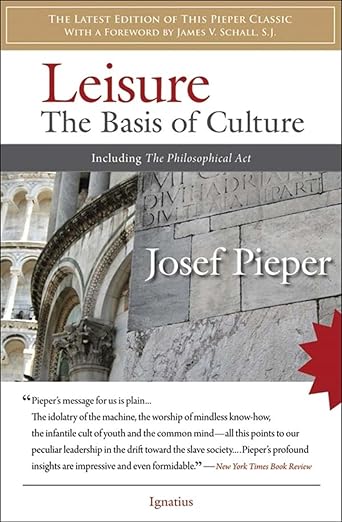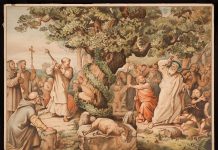One summer day last July, as the mists of morning fled before the strengthening rays of the sun, a group of families and young folk gathered together for Mass at a country shrine. There was much excitement and good cheer, as all present were preparing for a pilgrimage that day. The beautiful old stone shrine, built by monks and pioneers and dedicated to Our Lady of Mt. Carmel, is built upon a hill and stands as a witness to the faith of our fathers, overlooking a vast expanse of Saskatchewan farmland. Amidst the native grasses and vines, flowers grew in tumbled confusion where once a thoughtful gardener had planted them, while a mown lawn showed an expectant hope for pilgrim visitors. Upon the shrine grounds stands a large stone structure with two small towers at each end, an alcove and a high altar on which to celebrate Mass, several outer buildings, a large statue at the top of the hill, and Stations of the Cross set upon a trail which meanders through the bushes and up the hill. On this July morning the sun shone brilliantly upon the shrine’s light-coloured stone, quickly warming it while a deep blue sky encircled the scene like Our Lady’s mantle.
A bustle of preparation soon began as the boys made ready for Mass by arranging the altar, assigning altar-serving duties, sweeping away debris and ‘trying out’ the enormous bells. Meanwhile, the girls began to gather flowers and to pluck the weeds which had grown in the cracks in the cobblestones. It slowly dawned on me how perfectly fitting this little act of service was, how truly beautiful an offering for the King of King’s Who would soon descend upon the altar, and how entirely practical—yet impractical—a preparation! We surely did not require flowers at the altar or weed-free cobblestones; certainly the Mass would have continued without these little touches. Yet, precisely because they were small acts of love, I’m sure that from a heavenly perspective this country altar was as though inlaid with the finest gold, and the cobblestones shone as with rubies. After Mass was over and a light breakfast eaten, the pilgrims sang the Salve Regina and we began traversing the many miles of Saskatchewan country roads which lay before us.
In contemplating the idea of leisure, I couldn’t help but remember the beauty and tranquility of those countryside preparations for Mass. These little tasks done with simplicity and love illustrate that sometimes the ‘work we must do’ — that which is most fitting for the moment — is right in front of us. Catholics often discuss the question of how to positively impact culture, and rightly so. Our world is in a seemingly constant battle between a culture of life and a culture of death, and it often feels like a very steep uphill climb to find effective ways to fight for life. Josef Pieper offers a solution in his classic essay, Leisure: The Basis of Culture, arguing that a thriving culture requires a true understanding of leisure, which ultimately has its source in divine worship. He states that, “culture depends for its very existence on leisure, and leisure, in its turn, is not possible unless it has a durable and consequently living link with the cultus, with divine worship” (Pieper 15). Hence, a thriving Catholic culture must be rooted in the liturgy.
Pieper is speaking of culture as all those things that are extraneous to, but not disconnected from, religion and the day-to-day work. Namely, culture in this sense “is the quintessence of all the natural goods of the world and of those gifts and qualities which, while belonging to man, lie beyond the immediate sphere of his needs and wants” (16). It reaches beyond the practical necessities of life and often measures our willingness to elevate our souls toward higher things.
Leisure, as Pieper reminds us, creates the space for and can become a vehicle of silence, contemplation and receptivity to God’s will, thus allowing us to more easily answer the duty of the present moment. In this kind of silence, “the soul’s power to ‘answer’ to the reality of the world is left undisturbed” and thus more fully awake to reality as it truly is and our place within creation (46). This is not a silence of emptiness or complete noiselessness. Rather, it is a “receptive attitude of the mind, a contemplative attitude” which creates in man “the capacity for steeping oneself in the whole of creation” (46). Becoming poetical, Pieper refers to the contemplation of different aspects of creation, such as a “rose in bud” or a “child at play”, as an act which allows our mind to rest in Christ as in a “dreamless sleep”, evoking the image of God’s rest on the seventh day and our own final rest in heaven (46). The aforementioned image of the girls gathering flowers to prepare the altar for Mass illustrates beautifully a moment of leisure, contemplation, and ‘silence’ which blossomed into receptivity to the duty of the moment and, ultimately, an appreciation of creation in a way that gives back to the One who made it. Sometimes the most fitting thing to be done is indeed quite simple.
Culture certainly needs leisure to flourish; but let this not be mistaken for the idleness which often marks modern man’s ‘day off’. Pieper is very clear that idleness and leisure have no similarities, even though in our modern understanding we may conflate the two. In fact, he equates idleness with sloth, and says the “incapacity to enjoy leisure” is the result of restless activity stemming from an lack of desire “to be as God wants [us] to be” (44). Leisure, on the other hand, flows from divine worship and is thus an overflowing of man’s acceptance of who he is in relation to God. Since the Eucharist is the source and summit of the Christian life, true leisure is rooted in and flows from the liturgical life of the Church. It is manifested in an effortless outpouring of gratitude and in affirming that the world is indeed very good (48-49).
Pieper emphasizes that leisure must flow from worship, and not be sought for utilitarian ends. It must not be sought for the sake of being a better worker, or even to promote a stronger community. While these are indeed good ends, they cannot be final ends or the basis for our leisure. Pieper confirms that, “cut off from the worship of the divine, leisure becomes laziness and work inhuman” (68). He goes on to say that, “leisure cannot be achieved at all when it is sought as a means to an end, even though that end be ‘the salvation of Western civilization’. Celebration of God in worship cannot be done unless it is done for its own sake” (72). It is certainly one of the grand paradoxes of life that when we seek certain goods, like building community, for their own sake we will lose them; but whatever we lose for the kingdom of heaven we shall surely find again overflowing in abundance.
Since culture is dependant on leisure, and leisure on worship, then a truly thriving culture must have the liturgy, especially the Eucharist, at the centre of all festivity. No human institution can replace this. At the end of his essay Pieper asks the question which must be on the mind of anyone reading his work: what “are we to do about it?” (71). He replies that his essay was not meant to provide a plan of action, but “to make men think” (71). First we have to get our principles straight, and then, he says, everything else will fall into place. In essence, the solution is a renewed zeal for God and his sacraments, which ought to infuse the every-day activities of man. Naturally, we will then want to create space for an outpouring of our gratitude in response to God’s love, and we will want to celebrate well.
Another true story illustrates the ‘effortless outpouring’ into leisure which happens when Christ is at the centre of culture. The setting is again in Saskatchewan, this time the backyard of a family farm upon a warm September evening. A group of about ten, including family and friends, had been invited there to share a Sunday evening meal. We arrived anticipating an simple yet festive meal together in their lovely country home, when to our delight and surprise we were shown into their beautiful backyard where our hosts had prepared a garden party! The place was as though straight from a storybook, and the most idyllic setting for eutrapelia — that kind of conversation which graces old friendships with renewed charm and quickly cements new ones. Nestled in a green-space between shady trees and a charmingly crafted picket fence stood a long banquet table, set with tablecloth, china, silverware and crystal glasses. A delightfully warm summer breeze brought scents of the harvest lightly through the trees, and as our hosts bade us to sit we drank in the scene and exclaimed it to be ‘sublime’. There is nothing that opens the heart to a celebration quite like being a guest to such a feast, lovingly prepared by hosts who simply wish to create a moment of joy in friendship.
The party also commemorated two beloved queens, for it was the feast of the birth of Our Lady, Queen of Heaven and Divine Mother, and the death anniversary of our late Queen Elizabeth II. The evening had an English theme to it, with a delicious feast including a leg of lamb which was raised by our hosts. We toasted to the day and our hosts with good wine, enjoyed much lively and meaningful conversation, and shared some delicious cake afterwards, in honour of Our Lady’s birthday of course. Joy, laughter, and a sense of intimate tranquility pervaded this small yet cheery outdoor gathering. As the light began to fade, one of our party called for candlelight, to which the young lads responded by producing candles for the table and illuminating little twinkle lights in the garden which lit the yard as with fairy-like fireflies. Soon someone called for singing and a song was begun, a good old folk song as may have been sung at a similar party in days gone by, or upon an evening before a cosy fire. One song led to another, and then to some rounds, before the sun had truly set and the cool breezes announced the arrival of night. The party had drawn to its close, yet the merriment continued as each guest gathered glassware, cups and candles, and, with the young folk still singing, aided in bringing everything back to the house, forming a spontaneous procession of sorts up to the farm house, the windows of which glowed warm and welcoming in the dusky twilight. ’Twas truly a memorable evening overflowing with joy and stemming from a desire to share the gift of Sunday together.
Ultimately, all vibrancy within culture is rooted in Christ and his sacraments, and is often manifested in the little day-to-day things that teach us to grow daily in love for Him. True leisure carries us out of the hum-drum of the everyday work into an experience of what it means to be truly human and children of God (74). In these moments of leisure we affirm that what God created is indeed very good. We may catch a glimpse of the transcendent, whether we see it on a mountaintop, in the faces of our family, in company with friends or perhaps alone in the quiet firelight with a book. It may be on a hill in Saskatchewan, watching young ladies gather flowers for Mass, or at home receiving a dandelion from a gleeful, easily distracted toddler. Each of these moments are a reminder that life is a gift and that ultimately our true home is with the divine Gift Giver, Whom we are born to worship and to Whom we aim to give our lives as a canticle of thanksgiving.
Works Cited:
Pieper, Josef. Leisure: The Basis of Culture. trans. by Alexander Dru. (San Fransisco, USA: Ignatius Press, 2009).











